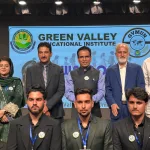Srinagar, Aug 09: Many rural areas in Kashmir continue to face disease outbreaks and infections due to the lack of drinking water testing facilities which is putting people’s health at risk.
People from several areas of Kandi Baramulla said that there are many water tanks in the area that have no testing facilities and people often complain of unsafe drinking water.
“There are some five water tanks in our area that have been functional over the past ten years and these do not have proper water testing facilities putting people at risk of catching infections,” said Farooq Ahmad, a resident of Kalantra village.
Similarly, people in the Yadipora area complained that a filtration plant was set up some five years back by the PHE Department; however, it developed a technical snag in its motor after a few months but that has not been repaired so far.
Ishfaq Ahmad, a resident, said they now get the drinking water from a direct canal that comes directly from Tangmarg which is also contaminated and can cause diseases.
“Previous year witnessed numerous individuals testing positive for water-borne illnesses, with a significant number also grappling with skin infections, a matter of great concern,” stated the resident. “During rainfall, we experience the issue of contaminated water, which is unsuitable even for drinking, let alone testing,” he said.
Likewise, in Mawer region of Handwara, the absence of a water filtration facility and a lack of water testing laboratory have left the residents wary of potential waterborne infections.
“We receive water directly from canals and streams, and the fact that this water is not tested raises significant concerns. A filtration plant should be a fundamental provision, but unfortunately, we have been overlooked in terms of such essential facilities,” expressed a Mawer resident.
Khalid Ahmad, hailing from Pulwama district in south Kashmir, highlighted that despite being aware of the water’s contamination, people lack familiarity with available laboratory testing facilities where they can have their water tested.
“Government needs to encourage people to go for water testing and they should make people aware of it. This can prevent spread of waterborne diseases,” he said
Shafat Ahmad, who resides in Tarhama, Tangmarg, pointed out the absence of water filtration facilities in the locality, leading to the consumption of contaminated drinking water. Furthermore, the area also lacks a testing laboratory for water quality assessment.
“We have a water pipeline that comes from Utitoo village, but that is too old and its pipes are damaged and have not been replaced or repaired so far,” he said.
Last week, Riyar village in Khansahib area of Budgam witnessed jaundice cases and people there blamed Jal Shakti Dept. for failing to provide safe drinking water in the village.
The Riyar village witnessed the death of a 10-year-old allegedly due to jaundice and nearly 8 people were infected with Hepatitis A virus due to contaminated water.
“We have taken up the matter with the PHE Dept. many times. Once there is any Hepatitis outbreak, local PHE local authorities are taken on board to rectify the matter,” said a resident of Riyar village.
In the past also southern Kashmir districts have been in news for hepatitis A, B and C cases which were mostly reported in winter months and reported by Rising Kashmir.
However, Chief Engineer, Jal Shakti (PHE) Department Kashmir, Sanjeev Malhotra said there are 53 water testing labs across Kashmir and people are free to get drinking water tested there.
“Over the years, there has been a lot of change. We have also given water testing kits in Panchayats and we have also kept the kits in many Higher Secondary Schools,” he said.
The CE said the department has sample collectors and takes the samples on a regular basis in different areas and gets it analyzed in district or sub-divisional testing labs.
Malhotra agreed that the department doesn’t have testing labs at every installation. He said there are labs at district and sub-division level and major installations have testing facilities.
“So far out of 53 labs, there are 11 labs that are accredited by the National Accreditation Board for Testing (NABL). We are in the process of upgrading all the systems to ensure that people get quality water in rural areas. We are working to get all labs accredited and the process is on,” he said.





